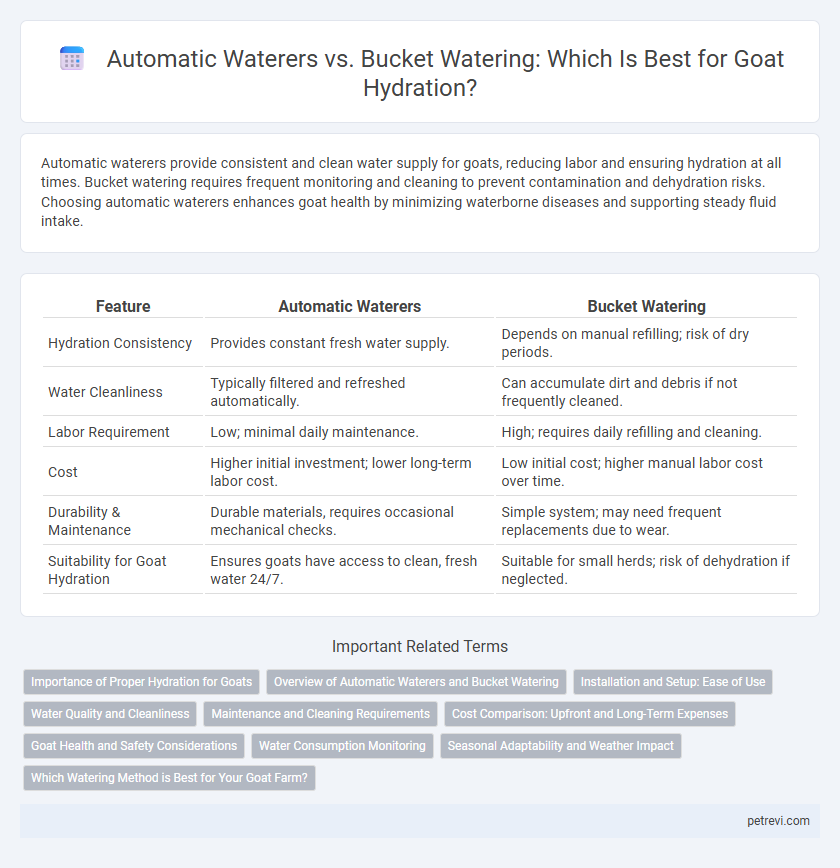Automatic waterers provide consistent and clean water supply for goats, reducing labor and ensuring hydration at all times. Bucket watering requires frequent monitoring and cleaning to prevent contamination and dehydration risks. Choosing automatic waterers enhances goat health by minimizing waterborne diseases and supporting steady fluid intake.
Table of Comparison
| Feature | Automatic Waterers | Bucket Watering |
|---|---|---|
| Hydration Consistency | Provides constant fresh water supply. | Depends on manual refilling; risk of dry periods. |
| Water Cleanliness | Typically filtered and refreshed automatically. | Can accumulate dirt and debris if not frequently cleaned. |
| Labor Requirement | Low; minimal daily maintenance. | High; requires daily refilling and cleaning. |
| Cost | Higher initial investment; lower long-term labor cost. | Low initial cost; higher manual labor cost over time. |
| Durability & Maintenance | Durable materials, requires occasional mechanical checks. | Simple system; may need frequent replacements due to wear. |
| Suitability for Goat Hydration | Ensures goats have access to clean, fresh water 24/7. | Suitable for small herds; risk of dehydration if neglected. |
Importance of Proper Hydration for Goats
Proper hydration is critical for maintaining goats' health, supporting digestion, and preventing dehydration-related illnesses. Automatic waterers provide consistent, clean water supply, reducing labor and minimizing contamination risks compared to bucket watering. Ensuring goats have constant access to fresh water directly impacts their productivity, immune function, and overall well-being.
Overview of Automatic Waterers and Bucket Watering
Automatic waterers provide goats with a continuous supply of fresh water through a connected water source, reducing labor and ensuring consistent hydration. Bucket watering requires manual refilling and cleaning, which can be time-consuming and may lead to water contamination if not maintained properly. Both methods influence hydration quality, but automatic waterers optimize convenience and water cleanliness essential for goat health.
Installation and Setup: Ease of Use
Automatic waterers offer straightforward installation with minimal maintenance, featuring self-filling systems that ensure constant water availability for goats. Bucket watering requires manual refilling and regular cleaning, which can be time-consuming and less convenient. The ease of use of automatic waterers enhances goat hydration efficiency by reducing labor and preventing water contamination.
Water Quality and Cleanliness
Automatic waterers provide a continuous supply of fresh, filtered water, significantly reducing contamination risks compared to bucket watering, where stagnant water can promote bacterial growth. High water quality is crucial for goats' health, and automatic systems minimize exposure to dirt, debris, and algae commonly found in buckets. Maintaining clean hydration sources through automatic waterers enhances goats' overall welfare and reduces the likelihood of waterborne illnesses.
Maintenance and Cleaning Requirements
Automatic waterers for goats require regular inspection to ensure sensors and valves function properly and prevent leaks, while bucket watering demands daily cleaning to avoid algae buildup and bacterial contamination. Automatic systems often include self-cleaning features but may still accumulate mineral deposits requiring periodic descaling. Bucket watering allows for easy portability and immediate visual water quality checks but increases labor due to frequent refilling and sanitation tasks.
Cost Comparison: Upfront and Long-Term Expenses
Automatic waterers for goats have a higher upfront cost, typically ranging from $100 to $300, but offer consistent hydration and reduced labor over time. Bucket watering requires minimal initial expense, often under $20, but entails regular manual refilling and cleaning, increasing labor costs and time investment. Considering long-term expenses, automatic systems can be more cost-effective by preventing water waste, reducing disease risk, and saving labor hours compared to traditional bucket watering methods.
Goat Health and Safety Considerations
Automatic waterers provide goats with a consistent supply of clean, fresh water, reducing the risk of contamination and dehydration compared to bucket watering. Buckets require regular cleaning and frequent refilling to prevent bacterial growth that can compromise goat health. Investing in automatic waterers enhances hydration management and supports overall goat welfare by minimizing exposure to harmful pathogens.
Water Consumption Monitoring
Automatic waterers provide consistent, fresh water and enable precise monitoring of goat hydration through integrated flow meters that track daily consumption. Bucket watering requires manual refilling and offers no direct measurement of individual water intake, making it challenging to detect early signs of dehydration. Precise water consumption data from automatic systems supports better health management and timely intervention in goat care.
Seasonal Adaptability and Weather Impact
Automatic waterers provide consistent hydration for goats regardless of season, maintaining optimal water temperature and reducing the risk of freezing in cold weather. Bucket watering requires frequent monitoring to prevent water contamination and freezing during winter, posing hydration challenges. Seasonal adaptability favors automatic systems that ensure reliable water access and promote overall goat health year-round.
Which Watering Method is Best for Your Goat Farm?
Automatic waterers provide a consistent and clean supply of water, reducing labor and minimizing contamination risks compared to bucket watering. Buckets require frequent manual refilling and cleaning, increasing the potential for algae growth and bacterial buildup that can affect goat health. For large-scale goat farms seeking efficiency and optimal hydration, automatic waterers offer superior practicality and hygiene benefits.
Automatic Waterers vs Bucket Watering for Goat Hydration Infographic

 petrevi.com
petrevi.com